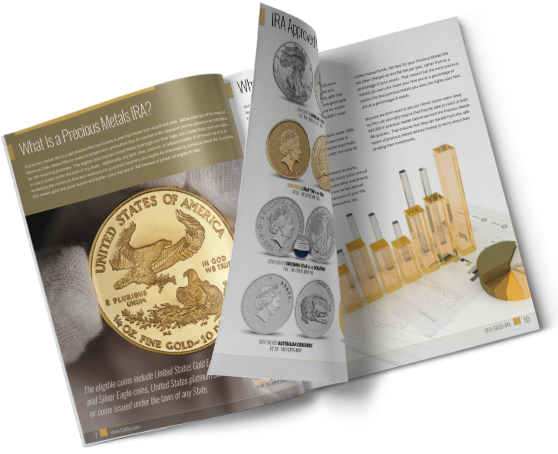
401(k) Rollover
As you get older, you may start looking into the many ways in which you can stash money aside for retirement. If you have an old 401(k) from an employer that is sitting idle, transferring all or part of your 401(k) into a rollover IRA with gold investments is a popular option. You may not be aware, but the company managing the fund takes fees from your 401(k) even when you aren’t contributing. Over time, those fees can add up to a significant amount if you’re not continually contributing money. Using a 401(k) rollover to transfer your assets to an IRA will broaden your investment choices.
Moving your retirement funds into a Self-Directed IRA gives you the opportunity to invest in 401(k) rollover options like real estate, bonds, private lending, and precious metals like gold and silver. This makes a 401(k) to IRA rollover in order to invest in gold and other precious metals a very popular option. These precious metals have been used as a time-tested means of storing wealth for thousands of years.
Precious metals can be seen as a hedge, or portfolio insurance. Recessions are cyclical; it is not a matter of if, but when the next one will happen. Many were caught in the Great Recession of 2008 and are still recovering to this day. Because the price of precious metals tends to increase during tough economic times, your portfolio will remain stable even during recessions. Even if you choose to leave your job, it is possible to keep the funds you have earned in one place as long as you carefully select the 401(k) rollover option that best suits your circumstances.
If you have another form of an employer-sponsored retirement plan, you may still be eligible for a rollover. Check out our Gold IRA Rollover guide to get more information about the qualified plans, as well as a more in-depth step by step process about opening a gold IRA with Goldco. Our specialists are standing by to guide you, so don’t hesitate to reach out by filling out the form on the right-hand side of the page or by calling us at (855) 465-3472.
What is a 401(k) Plan?
Section 401(k) is a section of the Internal Revenue Code that allows individuals to make contributions in a tax-deferred manner. This means that they will not be taxed on that contribution until they take a distribution when they retire (at age 59 1/2 or later). Like IRAs, 401(k)s are subject to RMDs or required minimum distributions, which require investors age 70 1/2 and older to take a specific amount in distributions each year. Use this calculator to learn how to take RMDs and avoid penalties.
Some companies may match part of an employee’s salary, which allows individuals to save additional money for retirement. Taking advantage of an employer match is a smart way to plan for the future and it’s often called “free money.”
401(k) gold rollover plans come with many benefits:
- Allows employees to save money easier by automatically withdrawing from their paychecks into their retirement accounts.
- Many companies will match employee contributions to help employees build their nest egg for retirement.
- The money that employees contribute to their retirement accounts is tax-deferred. This means that the money they contribute to their 401(k) will not be taxed. If you are making $45,000 a year and you contribute $5,000, you will be taxed on $40,000 rather than the full $45,000 meaning you pay lower taxes on your income. You will, however, need to pay the taxes when you take the withdrawal in retirement.
- Under certain circumstances, you can borrow from your 401(k) – to pay for: unforeseen medical emergencies, burial or funeral expenses for the family, education, towards the purchase of your principal residence, to prevent eviction, and to repair damage to your principal residence after certain casualty losses. Try to avoid this option, as your distributions will lose any market gains. Lastly, check with your company’s 401(k) loan plan and be sure to make timely payments to avoid taxes as well as a 10% penalty.
Indirect vs. Direct 401(k) Rollover
An indirect rollover is a process of transferring assets from a tax-deferred plan to an IRA. Funds are sent by check to the owner of the account and must be transferred to the IRA within 60 days to avoid an IRS penalty. There are some rules that apply, like the withholding rule that can cost the individual 20% of the amount to be transferred. This method should only be used if you absolutely need your money during those 60 days. You also are allowed only 1 indirect rollover per 12-month period.
A direct rollover is a process of transferring an individual’s retirement funds from trustee to trustee (or custodian to custodian). Since the assets never reach the individual investor, this method is penalty–free and not taxable. This is the best method, and accounts like 403(b)s, government (457)s, qualified plans (I.e 401(k)s, profit sharing, and money purchase plans) qualify for a direct rollover. This strategy can be performed an infinite number of times during a one-year period.
A Lack of Choice
While 401(k) plans have their benefits, one major drawback is a lack of choice regarding investment options. 401(k) plans tend to give you a small selection of funds to choose from, with many being loaded with fees. These fees might seem small but can eat into your returns over time.
If you implement a 401(k) rollover into a self-directed IRA, you’re in control of your retirement. You pick what you want to invest in, and you control how those funds are directed. You can invest in real estate, bonds, private lending, precious metals, and more. Fortunately, if you complete a direct rollover of your retirement assets, you can do this penalty–free and you will be free to open a self-directed IRA and start investing in the assets mentioned above.
Long Gone Are the Days of Pensions
Pensions in the United States have been around for over 160 years. They were designed to allow individuals to have guaranteed income when they retired. Over time, this proved to be a burden on companies because life expectancy has increased significantly over the last 200 years, which led to excessive costs. This continues to be an issue today, with many pensions becoming insolvent. Most private sector employers have chosen the 401(k) plan as an alternative. Most government and public sector industries still have pensions, but this change has forced individuals to take charge of their own retirement income.
Pensions can also be used to fund self-directed IRAs via a pension to 401(k) rollover.Besides this, most people can choose to take these investments either as a lump sum or stream of income. There are many factors to consider when choosing these options like inflation risk, immediate income need, and estate planning strategies. Be sure to check with your plan administrator and financial advisor for specific rules and regulations.
Social Security – Gone by 2034
Social Security in the United States was signed into law by President Franklin D. Roosevelt in 1935 and is a government-sponsored program that allows retirement-age individuals to have a basic income in retirement. This program is funded by payroll taxes and designed to help prevent poverty for Americans who are no longer able to work. Every tax-paying employed individual in the United States contributes to this program.
Social Security benefit payments are now around $1 trillion per year; this is only expected to increase in the future due to the average life expectancy increasing.Analysts are predicting that the Social Security trust fund will be bankrupt by 2034,which will cause benefits to decrease to less than 80 percent at that point, and even lower in the future. Thus, individuals are becoming increasingly responsible for their own future and retirement.
Don’t let your 401(k) sit idle and let the fees eat away at your portfolio. Contact a Goldco representative and complete your 401(k) rollover to gold today.

Ready to Protect Your Retirement Savings?
Get our FREE Self-Directed IRA Guide
With the Goldco self-directed IRA guide, you’ll learn everything there is to know about investing in gold and silver with a precious metals IRA. Whether you’re a long-time precious metals investor or a first-time buyer, our FREE guide will explain the advantages of precious metals IRAs, how to get started investing in precious metals, and how long the IRA process will take.
Once you’ve read our FREE IRA guide, our specialists are available to answer any additional questions you have about opening a gold or silver IRA. If you’ve wished you could invest in gold and silver but didn’t know how, request your FREE self-directed IRA guide today and learn how you can harness the power of gold and silver to protect your retirement savings, grow your wealth, and add much-needed stability to your investment portfolio.

Ready to Protect Your Retirement Savings?
Get our FREE Self-Directed IRA Guide
With the Goldco self-directed IRA guide, you’ll learn everything there is to know about investing in gold and silver with a precious metals IRA. Whether you’re a long-time precious metals investor or a first-time buyer, our FREE guide will explain the advantages of precious metals IRAs, how to get started investing in precious metals, and how long the IRA process will take.
Once you’ve read our FREE IRA guide, our specialists are available to answer any additional questions you have about opening a gold or silver IRA. If you’ve wished you could invest in gold and silver but didn’t know how, request your FREE self-directed IRA guide today and learn how you can harness the power of gold and silver to protect your retirement savings, grow your wealth, and add much-needed stability to your investment portfolio.



